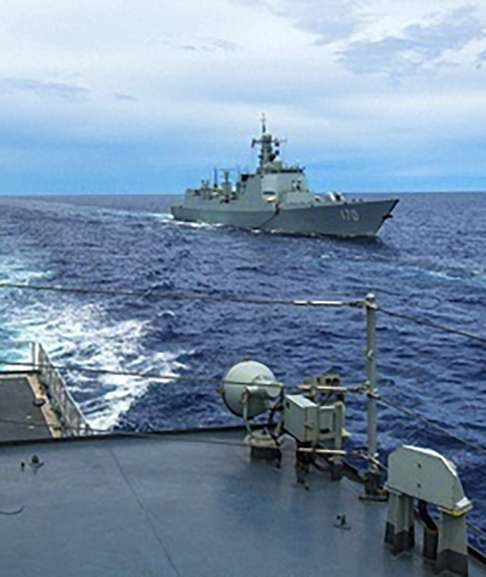US and Japanese warships keep close watch on Chinese navy combat drill
The 48-hour non-stop exercise comes amid escalating tension between China and the US

A Chinese naval strike group conducted a 48-hour non-stop combat drill in the western part of the Pacific Ocean under the close surveillance of US and Japanese warships, Chinese state media reported on Tuesday.
The drill, conducted on Sunday and Monday, involved some of the People’s Liberation Army Navy’s most advanced warships.
A US destroyer, a Japanese destroyer along with two anti-submarine helicopters followed and monitored the drill from a visible distance, the website of the PLA Daily reported.
The warships were also involvedin an exercise in the South China Sea earlier in the month, marking a rise in regional military tensions between China and the United States.
The vessels were from the PLA Navy’s South Sea Fleet and had left a naval base in Sanya, Hainan province, earlier this month.
The strike group conducted an attack and defence exercise off Subi Reef, and the ships also patrolled Chinese-controlled Johnson South Reef, Fiery Cross Reef, Cuarteron Reef, Mischief Reef, the Gaven Reefs and Hughes Reef in the Spratly Islands on May 8 to 9.
The next day, the guided-missile destroyer USS William P. Lawrence travelled within 12 nautical miles of Chinese-occupied Fiery Cross Reef in a freedom of navigation operation.
“The types of exercises show the PLA has prepared for the worst,” Ni Lexiong, a Shanghai-based expert on naval strategies, said.
In the most recent drill, the Chinese destroyers Lanzhou and Hefei, frigate Sanya and a team of bombers practised strikes against the destroyer Guangzhou and the frigate Yulin. A submarine acted as a third-party threat to both sides. Supply ships and early warning aircraft were also involved in the exercise, according to reports.
Both sides opened fire to test their artillery, an earlier PLA Daily report said.
The presence of US and Japanese warships complicated this week’s exercise as both sides had to stay alert for foreign vessels and aircraft while conducting the exercise, the Hefei’s captain, Zhao Yanquan was quoted as saying.

As part of the South Sea Fleet’s annual comprehensive open sea drills, the strike group will move on to do exercises in the Eastern Indian Ocean, where the Chinese navy has not been very active.
Ni said the PLA had to demonstrate its maritime power to other countries as part of China’s broader “One Belt, One Road” initiative.
“Military presence is in itself economically valuable,” Ni said. “It does not necessarily have to be a war. The confirmed military advantage could translate into money, into business projects, and into support in international disputes.”
The report of the drill comes amid rising tensions between China and the US over the disputed South China Sea. Despite this, the Chinese navy will take part in the US-led Rim of the Pacific Exercise, the world’s largest naval drill, off Hawaii in June and July.
Last week, two Chinese J-11 fighter jets intercepted a US EP-3 reconnaissance aircraft.
The Pentagon said the interception was unsafe, but Beijing rejected the claim, saying the Chinese operation was professional and in line with the law.